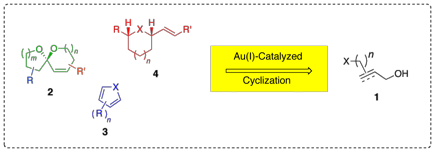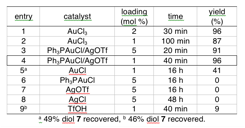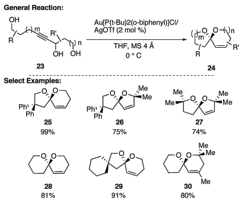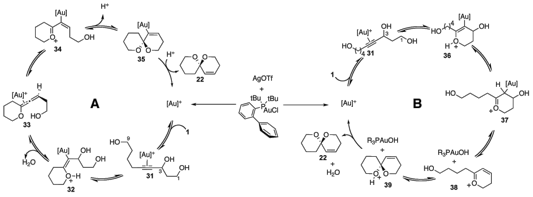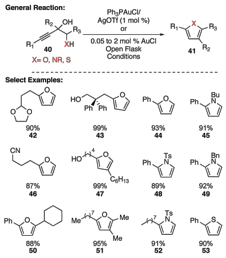Reports: G1
47539-G1 Harnessing the Reactive Intermediates of Catalytic-Heterofunctionalization
With the support of this ACS-PRF grant we have made significant progress in the discovery of new dehydrative reactions of unsaturated alcohols during the last year. Our work has been focused on developing allylic and propargylic alcohols as electrophiles in gold-catalyzed processes whereby a tethered nucleophile adds to the pi-bond with concomitant loss of water (Scheme 1). This is a new mode of reactivity in the burgeoning area of homogenous gold catalysis, which enables the preparation of a variety of ubiquitous structural motifs and as such should find use in total synthesis.
Scheme 1. Au-catalyzed dehydrative cyclizations of unsaturated alcohols.
At the outset, it was our intention to search for new catalytic heterofunctionalization reactions of alkenes that proceed under mild reaction conditions and would be suited for use in complex molecule synthesis. Through a series of preliminary experiments, it was found that allylic alcohols are extremely reactive towards gold catalysts. Treatment of alcohols such as crotyl alcohol 5 in benzene at room temperature with 5 mol % Ph3PAuCl and AgOTf, results in ether products such as 6, which was isolated in 24% yield (Scheme 2). Although the high catalyst loading and low yield left significant room for improvement, this was the first indication that unsaturated alcohols may undergo Au-catalyzed dehydrative transformations. Through further experimentation it was later discovered that intramolecular reactions of substrates containing a tethered nucleophile smoothly yielded the cyclic ether products (e.g. 7 to 8, Table 1). Careful control experiments demonstrated that both the gold and silver complexes are necessary for the reaction (Table 1).
Scheme 2. Initial experiments.
Table 1. Optimization studies.
Further studies were designed to probe the effects of substitution on the allyl moiety and the results are shown in Figure 1. A variety of substrates performed well in the reaction including cis olefins, aldol adducts, tertiary allylic alcohols, tri-substituted olefins (forming a quaternary stereogenic center), and other assorted functional groups. The reaction proceeds in high yield in all cases with high cis selectivity when applicable. In addition, the reactions could be performed at temperatures as low as -78 °C and the catalyst loadings could be reduced to 0.1 mol % without negative consequences.
Figure 1. Select examples of Au-catalyzed cyclic ether formation.
Based on these results, the analogous propargylic diols would be predicted to undergo similar reactions, although the products produced would be allenol ethers. We reasoned that these reactive intermediates could be utilized in an efficient process if an additional alcohol were present in the molecule, and would form unsaturated spiroketals such as those contained in natural products like spirastrellolide A and okadaic acid. The reaction sequence would be predicted to proceed from the triol 20 to the spiroketal 22 via the allenol ether 21 (Scheme 3). In principle, both processes could be catalyzed by a cationic metal. This route was particularly attractive because the olefin would be precisely placed according to the general scheme leaving no ambiguity in the sizes of the rings formed, which is often a challenging issue.
Scheme 3. Cyclization of propargyl triols.
Gratifyingly, this reaction sequence works extraordinarily well, smoothly generating the desired products in high yield (Figure 2). Interestingly, the reaction functions best when Au[P(t-Bu)2(o-biphenyl)]Cl is employed with AgOTf in THF at 0 °C. The loading can be reduced to 2 mol% with reaction times ranging from minutes to just less than 1.5 h. Control experiments suggest that Au[P(t-Bu)2(o-biphenyl)]OTf is the active catalyst and rule out the possibility that the reaction is catalyzed by TfOH.
Figure 2. Au-catalyzed formation of unsaturated spiroketals.
The results demonstrate that a variety of ring sizes can be formed and that substrates with substitution at a range of positions function well in the reaction. Even tertiary propargylic alcohols are tolerated in the reaction producing products such as the trisubstituted olefin 29. This type of alkene product is interesting because a trisubstituted olefin would be needed in the synthesis of okadaic acid.
A likely catalytic cycle for the reaction is presented in Scheme 4. Experimental evidence using the diol generated by protection of the C1 or C9 hydroxyl group suggests that either the C1 or C9 alcohol may cyclize first but both events eventually lead to the same product.
Scheme 4. Competing catalytic cycles.
We have also demonstrated that propargyl alcohols can undergo dehydrative cyclization when only one additional nucleophile is present. For such a system to function well, we reasoned that, in the absence of a second nucleophilic alcohol, a different pathway for further reactions would be necessary. To address this, heteroatom substituted substrates such as 40 were prepared and treated under the same reaction conditions (Figure 3). These systems rapidly aromatize to form 5-membered heteroaromatics in high yield. Additionally, it was found that AuCl could be used as catalyst in an open vessel without taking any precautions to exclude air or moisture. The reaction is very simple to perform (essentially no precautions are necessary), rapid, high-yielding, exceptionally clean (no additional product purification is generally necessary), and the catalyst loadings are exceedingly low (as low as 0.05 mol%).
Figure 3. Formation of heteroaromatics
The results outlined above demonstrate that unsaturated alcohols undergo a variety of dehydrative transformations under extremely mild conditions. These methods enable facile preparation of highly useful cyclic ethers, monounsaturated spiroketals, and five-membered heteroaromatics from readily prepared diols and triols. The reactions are rapid and generally high yielding providing a concise synthesis of functional building blocks in short order. Additional reactions of this ilk are being developed and will be reported in due course.

